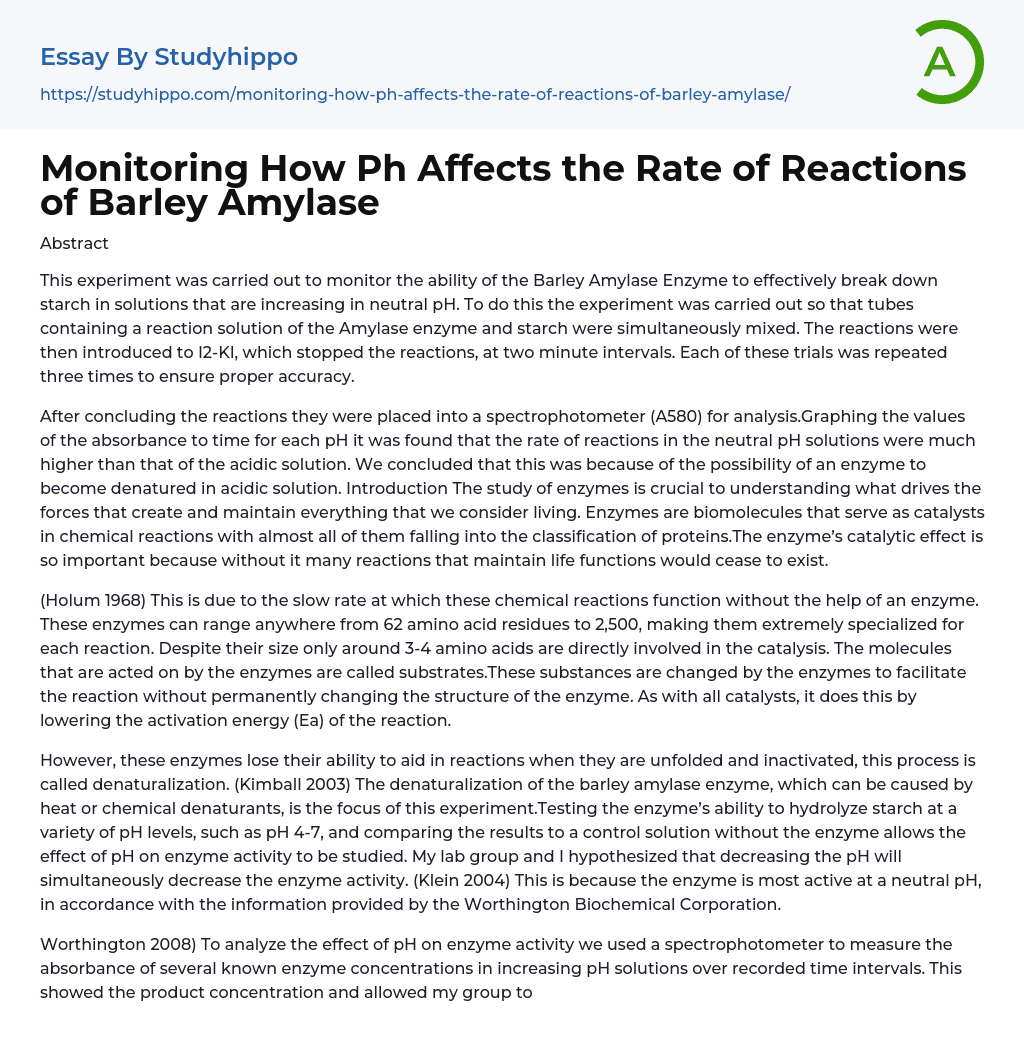

Monitoring How Ph Affects the Rate of Reactions of Barley Amylase Essay Example
Abstract
This experiment aimed to monitor the efficacy of the Barley Amylase Enzyme in breaking down starch in solutions with increasing neutral pH levels. The experiment involved simultaneously mixing tubes containing a reaction solution of Amylase enzyme and starch. The reactions were then stopped using I2-KI at two-minute intervals. To ensure accuracy, each trial was repeated three times. After the reactions were concluded, they were analyzed using a spectrophotometer (A580). The absorbance values were graphed against time for each pH, revealing that the rate of reactions was significantly higher in neutral pH solutions compared to acidic solutions.
In summary, the likely reason for this phenomenon is the denaturation of enzymes in an acidic solution. The significance of studying enzymes to understand life's fundamental driving forces is highlighted in the introduction. Enzymes are biomolecules that act as catalysts in chemi
...cal reactions, with most being classified as proteins. The catalytic effect of enzymes is crucial as it enables essential life-sustaining reactions. Without enzymes, these reactions would occur much slower. Enzymes vary in size from 62 amino acid residues to 2,500, indicating their specialization for specific reactions. However, only a small portion of amino acids (approximately 3-4) directly participate in catalysis (Holum 1968).
The substrates, which are the molecules acted on by enzymes, undergo a change facilitated by the enzymes during the reaction without altering the enzyme's structure permanently. By reducing the activation energy (Ea) of the reaction, enzymes, like catalysts, perform this function. However, when unfolded and inactivated, these enzymes lose their ability to assist in reactions, a process known as denaturation. In this experiment, the denaturation of the barley amylase enzyme, caused by heat or chemical denaturants, is
the focal point. By testing the enzyme's capability to hydrolyze starch under different pH conditions (pH 4-7) and comparing the results to a control solution lacking the enzyme, the impact of pH on enzyme activity is examined. Our hypothesis, my lab group and I, is that a decrease in pH will concurrently decrease enzyme activity.
According to Klein (2004), the enzyme's highest activity occurs at a pH level that is neither acidic nor basic. This claim is supported by information from the Worthington Biochemical Corporation (Worthington 2008). To investigate how pH affects enzyme activity, we employed a spectrophotometer to measure the absorbance of different enzyme concentrations in solutions with increasing pH levels at specific time intervals. By doing this, we were able to determine the product concentration and calculate the enzyme activity through comparison with a standardized curve. Our experiment started by creating a standard curve using the following procedure:
Prepare six test tubes according to the instructions provided in the table below. Then, cover the tubes with parafilm and shake them vigorously. Prior to inserting a test tube into the spectrophotometer, make sure to remove the parafilm. Utilize the spectrophotometer to measure the absorbance at a wavelength of 580 nm, using the first tube as a reference.
(Do not discard “blank” tube until the experiment is finished). Plot the absorbance at 580 nm on graph paper.
Results
The results indicate that the hydrolysis reaction between starch and amylase enzyme exhibited a higher rate in neutral pH solutions. The reaction between amylase and starch results in the separation of the disaccharide maltose. As the reaction continues, the amount of starch decreases while the amount of maltose (sugar) increases.
(Bernfield 151) The
activity of amylase in the laboratory was observed by using iodine, as iodine reacts with starch to form a purple color. As amylase breaks down starch, less starch is present, causing the solution's color to become lighter. Our group's hypothesis was supported by the experiment's observations. The test tubes with more neutral pH solutions had higher absorbencies, indicating a higher rate of reaction. This supports our hypothesis that decreasing the solution's pH and increasing acidity increases the likelihood of enzyme denaturation (Worthington 2008). Enzymes can easily be denatured by various forces, such as chemical, ionic, and kinetic factors.
The enzyme demonstrates high activity in acidic or nearly neutral conditions, with over 50% of activity occurring between pH 4.6 and 6.8. The enzyme's optimal pH is 6.0, suggesting a preference for a slightly acidic environment (Bernfield 154).
Tables and Figures:
X Axis - Time (minutes)
Y Axis - Absorbance (580nm)
pH = 5
Time (min) 0 2 4
Absorbance (580 nm) 0.
7930.
References
- Division of Biological Sciences, The University of Georgia, Laboratory Manual For Principles of Biology I, 2007
- Holum, J. Elements of General and Biological Chemistry, 2nd ed., 377, Wiley, NY (1968).
- Klein, S. : Barley Amylase, http://www.chem.uwec.edu/Webpapers2005/leee/barley.html, University of Wisconsin, (2004)
- Kimball, J. : Enzyme Kinetics, http://users.
The following text contains and their contents, which should beand unified:
rcn.com/jkimball.ma.ultranet/BiologyPages/E/EnzymeKinetics.html, Harvard College, (2003)
- Worthington Biochemical Corporation: Effects of pH (Introduction to Enzymes), Lakewood, NJ, 2008
- Bernfeld, P., 1955.
- Amylase a and b.Methods in Enzymology.
1, 149-151.
- Acid essays
- Calcium essays
- Carbohydrate essays
- Carbon essays
- Chemical Bond essays
- Chemical Reaction essays
- Chemical reactions essays
- Chromatography essays
- Concentration essays
- Copper essays
- Diffusion essays
- Ethanol essays
- Hydrogen essays
- Organic Chemistry essays
- Osmosis essays
- Periodic Table essays
- Ph essays
- Salt essays
- Sodium essays
- Titration essays
- Bacteria essays
- Biotechnology essays
- Breeding essays
- Cell essays
- Cell Membrane essays
- Cystic Fibrosis essays
- Enzyme essays
- Human essays
- Microbiology essays
- Natural Selection essays
- Photosynthesis essays
- Plant essays
- Protein essays
- Stem Cell essays
- Viruses essays



